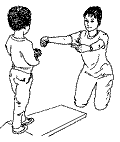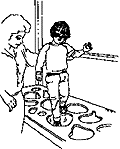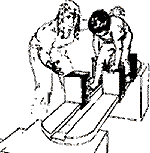The Miller Method®: A Cognitive-Developmental Systems Approach for Children on the Autism Spectrum
Arnold Miller, Ph.D. with Eileen Eller-Miller, M.A., CCC-SLP Language and Cognitive Development Center, Boston
The Miller Method addresses children's body organization, social interaction, communication and representation issues in both clinical and classroom settings. Cognitive-developmental (c-d) systems theory assumes that typical development depends on the ability of the children to form systems -- organized "chunks" of behavior -- that are initially repetitive and circular but which become expanded and complicated as the children develop. Becoming aware of the distinction between themselves and their immediate surroundings, children's systems, previously triggered only by salient properties of the environment, gradually come under their control. Children then combine their systems in new ways that permit problem solving, social exchanges and communication with themselves and others about the world.
In contrast, developmentally challenged children become stalled at early stages of development and progress to more advanced stages in an incomplete or distorted fashion. Many on the autism spectrum present an impairment in the ability to react to and influence the world. Lacking a sense of the body in relation to the world, salient stimuli drive them into scattered or stereotypic behavior from which, unassisted, they cannot extricate themselves. This results in aberrant systems involving people and/or objects as well as a "hardening" of transitory formations found in normal development, e.g., hand inspection and twiddling or intense object preoccupation.
The Miller Method uses two major strategies to restore typical developmental progressions: One involves the transformation of children's aberrant systems (lining up blocks, driven reactions to stimuli, etc.) into functional behaviors; the other is the systematic and repetitive introduction of developmentally relevant activities involving objects and people. Activities are chosen to fill developmental gaps. This process is facilitated by narrating the children's actions while they are elevated 2.5 feet above the ground on an Elevated Square and similar challenging structures. Elevating the children enhances sign-word guidance of behavior and body-other awareness as well as motor-planning and social-emotional contact. It also helps children transition from one engaging object or event to another or from object involvement to representational play.
Parents play an integral role in the program by generalizing the children's achievements at the Center to the home and elsewhere.
What is the philosophy behind The Miller Method®?
How do you assess the children?
What do you do about more limited reality systems once you discover them?
How do you help the children generalize what they learn at the Center to the home?
How do you deal with tantrums and other asocial behavior?
What is different about how you teach language?
Goals of the Miller Method® are to...
| What is the philosophy behind The Miller Method®? |
| We maintain that each child - no matter how withdrawn or disorganized - is trying to find a way to cope with the world. Our task is to help that child use every capacity or fragment of capacity to achieve this.
|
| How do you assess the children? |
Our Umwelt Assessment examines the unique way in which each disordered child experiences reality. We observe the manner in which the child reacts or fails to react to different parts of a situation. Figure 1 below indicates what we mean. 1a represents a child enjoying a repetitive pushing-ball game in which adult and child push a swinging ball back and forth. The dotted lines to both ball and adult indicate that the child's reality system includes awareness of both the ball and the adult. 1b, as the dotted line indicates, reflects a more limited reality system which includes the ball - as shown by his or her pushing it whenever it arrives - but not the adult. 1c shows an even more circumscribed reality system since here the child fails to react even when the ball bumps into him or her. |
| What do you do about more limited reality systems once you discover them? |
 We expand and transform limited reality systems and we enrich the child's repertoire by introducing new ones through spheric activity. When, through their work at the Center, the children learn to tolerate "stretching" their reality systems, or to accept new ones via repetitive spheres of activity, and can make transitions from one event to another without distress, their ability to cope with different life situations improves dramatically. We expand and transform limited reality systems and we enrich the child's repertoire by introducing new ones through spheric activity. When, through their work at the Center, the children learn to tolerate "stretching" their reality systems, or to accept new ones via repetitive spheres of activity, and can make transitions from one event to another without distress, their ability to cope with different life situations improves dramatically.For example, for the child in Figure 1b that includes the ball but not the adult, we find ways to include the adult within the child's object system or change it from a child-object system to a child-adult-object system. For the child in 1c we try to find out what gets in the way of the child's failure to react to the ball even when it hits the child. We determine if there are circumstances where the child can become aware of the ball: Some disordered children, for example, become more aware of an object when it approaches very slowly, others when they have repeated opportunity to push the ball. For children whose reality does not include simple systems such as climbing up stairs to go down a slide, we introduce a repetitive sphere of activity that guides the child up the steps, to sit and to slide down and repeat the sequence. To help the child succeed we may pace the activity quite rapidly so that the child can connect one part of it with another and, eventually, own the system. |
| How do you help the children generalize what they learn at the Center to the home? |
|
We build in the ability to generalize learning by the way we teach particular functions. For example, suppose a child is being taught to put cups on cup hooks. First, the worker helps the child put the cup on the hook by working hand-over-hand until the child can do this without support. Then, the worker moves about a foot or two away from the child so that the child must turn toward the adult to get the cup and then turn toward the cup hooks. Ultimately, the child learns to perform the cup-on-hook task while accepting cups of varied shapes and colors from different locations, presented in different positions, and presented by different people. This learning - occurring with the help of at least one parent - makes it possible for the child to perform such tasks at school, at home and elsewhere. |
| How do you deal with tantrums and other asocial behavior? |
| We view tantrums as a failure in the child's ability to cope with people or things in his or her surroundings. We try to understand the meaning of the tantrum - since this varies from child to child. For one child it may come about because he or she cannot cope with the shift from one situation to another and needs help with this. For another, it may stem from a feeling of loss triggered by a teacher turning to another child. Whatever the source of the tantrum, we do not deal with it by "time out" (placing the child in a space removed from teacher or other children). Instead, we try to meet the need being expressed, to signal transitions from one activity to another more clearly, and to use repetitive (and often reassuring) rituals to help the child reorganize. If all else fails we hold the child while talking to him or her calmly about what is happening in the classroom, what will happen next, etc. |
| What is different about how you teach language? |
 We find - in accord with other developmental theorists - that language begins with directed body action toward or with objects and events. We also find that when PDD children are placed on elevated boards 2 to 4 feet above the ground they become more aware of their bodies, better focused, and far more able to cope with obstacles or demands directly confronting them. Our research has shown that many children who cannot follow directions on the ground can do so in these elevated board situations. When we place obstacles in their paths and "narrate" what the children do as they climb over, in, through, across these obstacles, the children develop a repertoire of meanings which can readily be transferred to the ground. Since these "narratives" are accompanied by manual signs and words related to their actions the children soon become sign and word guided in these activities. We find - in accord with other developmental theorists - that language begins with directed body action toward or with objects and events. We also find that when PDD children are placed on elevated boards 2 to 4 feet above the ground they become more aware of their bodies, better focused, and far more able to cope with obstacles or demands directly confronting them. Our research has shown that many children who cannot follow directions on the ground can do so in these elevated board situations. When we place obstacles in their paths and "narrate" what the children do as they climb over, in, through, across these obstacles, the children develop a repertoire of meanings which can readily be transferred to the ground. Since these "narratives" are accompanied by manual signs and words related to their actions the children soon become sign and word guided in these activities. |
| Goals of the Miller Method® are to |
|



 Because the ability to assess and respond to the outside world is essential for survival, we have developed specialized training systems and instructional equipment to help make this possible. Because the ability to understand others and to express oneself is fundamental, we have developed methods for teaching communication through signed and spoken language. And because a disordered child affects all around him, we work closely with parents and families to create a supportive but sufficiently demanding home life so that new capacities to cope that have begun to flourish at the Center may generalize to home and elsewhere.
Because the ability to assess and respond to the outside world is essential for survival, we have developed specialized training systems and instructional equipment to help make this possible. Because the ability to understand others and to express oneself is fundamental, we have developed methods for teaching communication through signed and spoken language. And because a disordered child affects all around him, we work closely with parents and families to create a supportive but sufficiently demanding home life so that new capacities to cope that have begun to flourish at the Center may generalize to home and elsewhere.